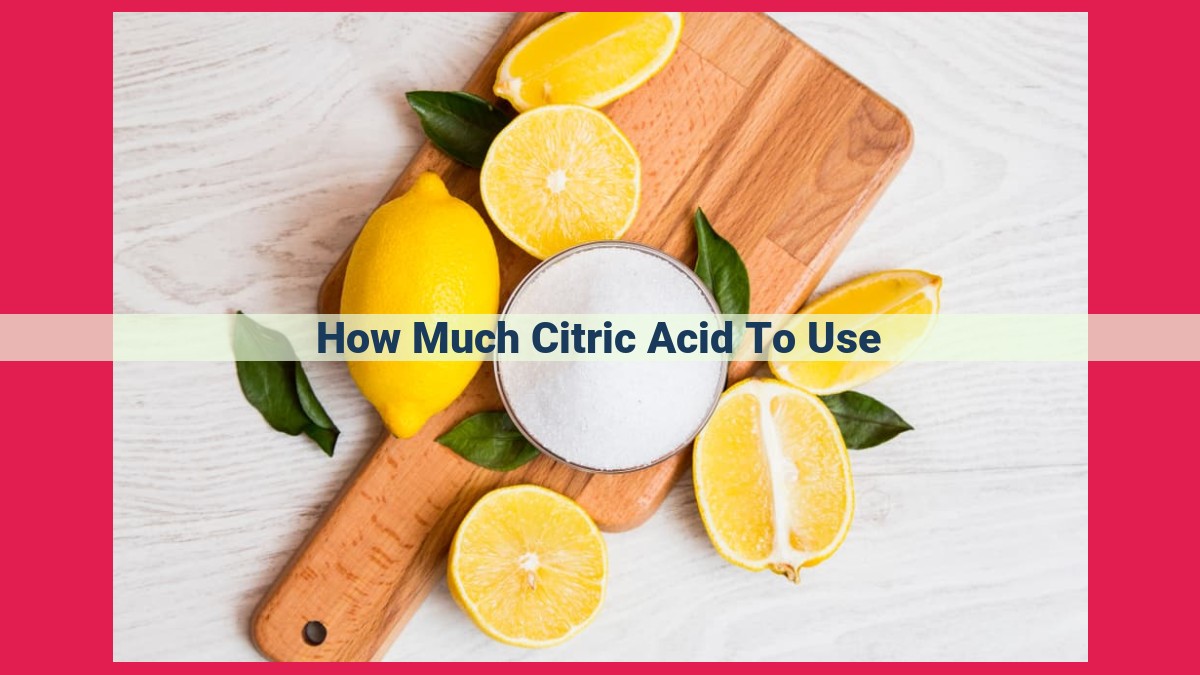How Much Citric Acid Should You Use? A Comprehensive Guide For Acidity And Tartness

Determining the optimal amount of citric acid to use involves considering several factors: acidity level (pH and desired tartness), type of citric acid (crystals, powder, solution), concentration, volume of liquid, personal preference (taste and sensitivity), food or beverage stability (preservation), and cost. The appropriate amount varies based on these factors, and it’s recommended to start with a small amount and gradually adjust to achieve the desired result.
How Much Citric Acid to Use: A Guide for Achieving Perfect pH and Flavor
When it comes to adding a burst of zingy flavor to your culinary creations, citric acid is your go-to secret weapon. But not everyone knows the golden rule: using the right amount of citric acid is key to unlocking the perfect balance of acidity and taste.
Citric acid, found in abundance in citrus fruits like lemons and oranges, plays a crucial role in regulating the acidity level of food and beverages. Understanding the pH scale is essential for mastering the art of citric acid usage. pH is a measure of acidity or alkalinity, ranging from 0 to 14. Acids have a pH below 7, while bases have a pH above 7.
Citric acid typically contributes to an acidity range of 3 to 6. This range encompasses the tart and sour sensations we associate with citrusy flavors. When you add citric acid to your food or beverage, you’re essentially “lowering” the pH, making it more acidic.
The amount of citric acid you need depends on the desired acidity level. For instance, a tart lemonade might require more citric acid than a mildly sour vinaigrette. Understanding the relationship between pH and acidity will help you achieve the perfect balance of flavors. So don’t shy away from experimenting a bit – the journey to culinary perfection is filled with delicious discoveries!
Type of Citric Acid: Navigating the Maze
Citric acid, a versatile culinary companion, comes in various forms, each offering unique benefits. Whether you’re a seasoned chef or a home enthusiast, understanding these forms will elevate your culinary adventures.
Crystalline Clarity: Citric Acid Crystals
- Crystalline clarity: These fine, white crystals pack a punch of acidity and are ideal for precise measurements.
- Suitable applications: Sprinkle them into sauces, baked goods, and desserts for a tart kick. Their ability to dissolve quickly makes them easy to incorporate.
Powder Perfection: Citric Acid Powder
- Versatile powder: This finely ground powder offers convenience and flexibility.
- Multiple uses: Sprinkle it over fruits and vegetables to preserve their freshness, add it to drinks for a refreshing tang, or use it as a cleaning agent. Its versatility knows no bounds.
Liquid Luxury: Citric Acid Solution
- Ready-to-use solution: This concentrated liquid provides a convenient and mess-free way to add acidity.
- Perfect for marinades and dressings: Its liquid form allows for easy mixing and ensures even distribution.
Choosing the Right Citric Acid for Your Needs
Your choice of citric acid form depends on your specific culinary endeavors. For precise measurements and a quick tartness boost, crystals reign supreme. If you seek versatility and ease of use, powder is your go-to. And for convenience and even distribution, solution is the perfect pick.
Understanding Concentration in Citric Acid: A Comprehensive Guide
When using citric acid, it’s crucial to understand its concentration. Concentration refers to the amount of citric acid present in a given volume of liquid. Different forms of citric acid have different concentrations, and choosing the right concentration for your application is essential.
Percentage, molarity, and normality are three common units of concentration.
Percentage: Measures the amount of citric acid in grams per 100 grams of solution. For example, a 10% citric acid solution contains 10 grams of citric acid per 100 grams of water.
Molarity: Measures the number of moles of citric acid per liter of solution. A mole is the amount of a substance that contains 6.022 x 10^23 molecules or ions. For example, a 1 molar (M) citric acid solution contains 1 mole of citric acid per liter of solution.
Normality: Measures the number of equivalents of citric acid per liter of solution. An equivalent is the amount of citric acid that can neutralize 1 mole of hydrogen ions (H+). For example, a 1 normal (N) citric acid solution contains 1 equivalent of citric acid per liter of solution.
To determine the concentration of citric acid in different forms, you can use the following equations:
- Percentage: Concentration (%) = (Weight of citric acid in grams / Total weight of solution in grams) x 100
- Molarity: Molarity (M) = (Moles of citric acid / Volume of solution in liters)
- Normality: Normality (N) = (Number of equivalents / Volume of solution in liters)
By understanding the different units of concentration and how to calculate them, you can ensure that you’re using the correct amount of citric acid for your specific application.
Volume of Liquid
- State the importance of measuring the volume of liquid being acidified.
- List common units of volume (gallons, liters, milliliters) and their abbreviations.
Volume of Liquid: A Crucial Element in Citric Acid Measurement
When acidifying liquids, accurately measuring the volume is paramount. The quantity of citric acid you add directly hinges on the volume of liquid you’re working with. The units of volume commonly used include:
- Gallons (gal)
- Liters (L)
- Milliliters (mL)
By precisely measuring the volume, you ensure a balanced and accurate acidity level that meets your desired taste profile and preservation requirements.
How Much Citric Acid to Use: Personalizing the Zing
When it comes to adding a tantalizing tartness to your culinary creations, citric acid is your secret weapon. But how much should you sprinkle in? The answer lies in a delicate balance between scientific precision and personal preference.
Taste and Sensitivity: A Tale of Two Tongues
Everyone’s taste buds are as unique as their fingerprints. Some savor the bolder, more acidic flavors, while others prefer a milder, more subtle tang. Your personal preference is the ultimate guide when determining the ideal amount of citric acid to use.
Dietary Concerns: Citric Acid and You
If you’re on a restricted diet, you may need to adjust the amount of citric acid you consume. Some people are more sensitive to acidity than others, and citric acid can potentially trigger heartburn or upset stomach. If you have any concerns, always consult with a healthcare professional before adding significant amounts of citric acid to your diet.
Citric Acid: A Comprehensive Guide to Enhancing Food and Beverage Stability
Embark on a culinary journey to uncover the secrets of citric acid, a versatile ingredient that transforms the world of food and beverages. In this comprehensive guide, we delve into the intricacies of citric acid usage, empowering you to fine-tune acidity levels, extend shelf life, and preserve the vibrant flavors of your culinary creations.
Citric Acid as a Preservation Powerhouse
Citric acid, a naturally occurring substance found in citrus fruits, acts as a potent preservative, safeguarding your delicious creations from the ravages of time. Its magical abilities stem from its ability to lower the pH of food and beverages, creating an acidic environment that inhibits the growth of spoilage-causing bacteria and yeasts.
Preservation Techniques Enhanced by Citric Acid
Harnessing the power of citric acid, you can employ a range of preservation techniques to extend the lifespan of your culinary masterpieces:
- Acidification: By adjusting the pH to below 4.6, citric acid can prevent the growth of harmful microorganisms, ensuring the freshness of your creations.
- Canning and Pickling: The acidic nature of citric acid makes it an ideal companion for canning and pickling, effectively preserving fruits, vegetables, and even meats.
- Jellies and Jams: The acidity of citric acid helps pectin to form a firm gel, creating delectable jellies and jams that retain their vibrant flavors.
Unlocking the Secrets of Citric Acid
By understanding the science behind citric acid, you can confidently navigate the world of food and beverage preservation. Keep these key points in mind:
- pH and Acidity: The lower the pH, the more acidic the food or beverage. Citric acid typically contributes to a pH range of 3-6.
- Concentration: The strength of the citric acid solution is measured in percentage, molarity, or normality.
- Personal Preferences: Taste buds vary, so adjust the amount of citric acid based on your desired acidity level.
- Stability: Citric acid not only enhances flavor but also acts as a preservative, extending shelf life.
Cost Considerations
Citric acid is an affordable ingredient, offering great value for your culinary endeavors. Purchasing in bulk can further reduce costs, making it a budget-friendly option for both home kitchens and commercial establishments.
By mastering the art of citric acid usage, you can elevate your culinary creations, preserve their flavors, and ensure their longevity. Let this guide be your beacon, illuminating the path to preserving the very essence of your culinary masterpieces.
Cost Considerations for Citric Acid
When incorporating citric acid into your culinary or household endeavors, cost is an important factor to consider. Citric acid is generally an affordable ingredient, but there are ways to further reduce its impact on your budget.
Bulk Discounts
Purchasing citric acid in larger quantities can lead to significant cost savings. Many retailers offer bulk discounts that can lower the cost per ounce or pound. Consider joining a wholesale club or purchasing directly from a supplier if you anticipate using large amounts of citric acid.
Availability
The availability of citric acid can also influence its price. Areas with limited access to citric acid may experience higher costs due to transportation and distribution expenses. Explore multiple stores or suppliers in your area to compare prices and find the most cost-effective option for your needs.
DIY Options
For those who have access to lemons, oranges, or other citrus fruits, making your own citric acid can be a cost-saving alternative. By squeezing the juice and drying it, you can create a natural form of citric acid without the added expenses of commercial products.
Alternative Sources
If citric acid is not readily available or affordable in your area, consider alternative sources of acidity. Lemon juice, vinegar, and other acidic ingredients can provide a similar flavor profile, allowing you to achieve your desired acidity level without breaking the bank.





